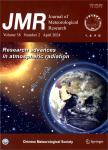Temporal Variation and Source Identification of Black Carbon at Lin'an and Longfengshan Regional Background Stations in China
Temporal Variation and Source Identification of Black Carbon at Lin'an and Longfengshan Regional Background Stations in China作者机构:State Key Laboratory of Severe Weather/Key Laboratory of Atmospheric Chemistry of China Meteorological AdministrationChinese Academy of Meteorological SciencesBeijing 100081
出 版 物:《Journal of Meteorological Research》 (气象学报(英文版))
年 卷 期:2017年第31卷第6期
页 面:1070-1084页
核心收录:
学科分类:07[理学] 070602[理学-大气物理学与大气环境] 0706[理学-大气科学]
基 金:Supported by the International Cooperation Program of Ministry of Science&Technology of China(2015DFG21960) National Natural Science Foundation of China(41505123 and 41275167) Fundamental Research Fund of Chinese Academy of Meteorological Sciences(2015Y002) National(Key)Basic Research and Development(973)Program of China(2014CB441201)
主 题:black carbon temporal variation source region atmospheric background station
摘 要:Black carbon (BC) is a component of fine particulate matter (PM2.5), associated with climate, weather, air quality, and people's health. However, studies on temporal variation of atmospheric BC concentration at background stations in China and its source area identification are lacking. In this paper, we use 2-yr BC observations from two background stations, Lin'an (LAN) and Longfengshan (LFS), to perform the investigation. The results show that the mean diurnal variation of BC has two significant peaks at LAN while different characteristics are found in the BC vari- ation at LFS, which are probably caused by the difference in emission source contributions. Seasonal variation of monthly BC shows double peaks at LAN but a single peak at LFS. The annual mean concentrations of BC at LAN and LFS decrease by 1.63 and 0.26 μg m 3 from 2009 to 2010, respectively. The annual background concentration of BC at LAN is twice higher than that at LFS. The major source of the LAN BC is industrial emission while the source of the LFS BC is residential emission. Based on transport climatology on a 7-day timescale, LAN and LFS stations are sensitive to surface emissions respectively in belt or approximately circular area, which are dominated by summer monsoon or colder land air flows in Northwest China. In addition, we statistically analyze the BC source regions by using BC observation and FLEXible PARTicle dispersion model (FLEXPART) simulation. In summer, the source regions of BC are distributed in the northwest and south of LAN and the southwest of LFS. Low BC concentration is closely related to air mass from the sea. In winter, the source regions of BC are concentrated in the west and south of LAN and the northeast of the threshold area of stot at LFS. The cold air mass in the northwest plays an important role in the purification of atmospheric BC. On a yearly scale, sources of BC are approximately from five provinces in the northwest/southeast of LAN and the west of LFS. These f



